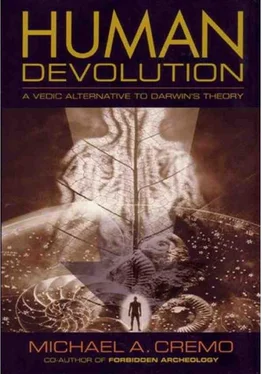Michael Cremo - Human Devolution - A Vedic Alternative To Darwin's Theory
Здесь есть возможность читать онлайн «Michael Cremo - Human Devolution - A Vedic Alternative To Darwin's Theory» весь текст электронной книги совершенно бесплатно (целиком полную версию без сокращений). В некоторых случаях можно слушать аудио, скачать через торрент в формате fb2 и присутствует краткое содержание. Год выпуска: 2003, ISBN: 2003, Издательство: Torchlight Publishing, Жанр: Старинная литература, на английском языке. Описание произведения, (предисловие) а так же отзывы посетителей доступны на портале библиотеки ЛибКат.
- Название:Human Devolution: A Vedic Alternative To Darwin's Theory
- Автор:
- Издательство:Torchlight Publishing
- Жанр:
- Год:2003
- ISBN:9780892133345
- Рейтинг книги:4 / 5. Голосов: 1
-
Избранное:Добавить в избранное
- Отзывы:
-
Ваша оценка:
- 80
- 1
- 2
- 3
- 4
- 5
Human Devolution: A Vedic Alternative To Darwin's Theory: краткое содержание, описание и аннотация
Предлагаем к чтению аннотацию, описание, краткое содержание или предисловие (зависит от того, что написал сам автор книги «Human Devolution: A Vedic Alternative To Darwin's Theory»). Если вы не нашли необходимую информацию о книге — напишите в комментариях, мы постараемся отыскать её.
Human Devolution: A Vedic Alternative To Darwin's Theory — читать онлайн бесплатно полную книгу (весь текст) целиком
Ниже представлен текст книги, разбитый по страницам. Система сохранения места последней прочитанной страницы, позволяет с удобством читать онлайн бесплатно книгу «Human Devolution: A Vedic Alternative To Darwin's Theory», без необходимости каждый раз заново искать на чём Вы остановились. Поставьте закладку, и сможете в любой момент перейти на страницу, на которой закончили чтение.
Интервал:
Закладка:
Evidence for extreme human antiquity is consistent with the ancient Vedic literature of India. This literature includes a group of writings called the Puranas, or histories. The Puranas inform us that humans have existed for vast periods of cyclical time. The basic unit of this cyclical time is the day of Brahma. The day of Brahma lasts for 4,320,000,000 years. It is followed by a night of Brahma, which also lasts for 4,320,000,000 years. The days and nights of Brahma follow each other endlessly. During the days of Brahma, life, including human life, is manifest, and during the nights of Brahma, life is not manifest. According to the Vedic cosmological calendars, the current day of Brahma began about 2 billion years ago. So a Vedic archeologist might expect to find evidence that humans have
18 HumAn DevoluTion: A vedic Alternative to Darwin’s Theory
existed for up to 2 billion years. The Puranas and other Vedic writings also speak of creatures with apelike bodies and humanlike intelligence. For example, the Shrimad Bhagavatam (9.18) tells of the monkey soldiers who assisted Lord Rama in defeating the demon Ravana. So a Vedic archeologist might also expect to find evidence for various types of apemen coexisting with humans of our type in the distant past.
Here is an example of the kind of evidence reported in Forbidden Archeology. In 1979, researchers at the Laetoli, Tanzania, site in East Africa discovered footprints in volcanic ash deposits over 3.6 million years old. Mary Leakey (1979) and others said the prints were indistinguishable from those of modern humans. To these scientists, this meant only that the australopithecines of 3.6 million years ago had remarkably modern feet. But according to other scientists, such as physical anthropologist R. H. Tuttle of the University of Chicago, fossil foot bones of the known australopithecines of 3.6 million years ago show they had feet that were distinctly apelike (Tuttle 1985). Hence they were incompatible with the Laetoli prints. In an article in the March 1990 issue of natural History, Tuttle (1990) confessed “we are left with somewhat of a mystery.” It seems permissible, therefore, to consider a possibility neither Tuttle nor Leakey mentioned—that creatures with anatomically modern human bodies to match their anatomically modern human feet existed some 3.6 million years ago in East Africa. In Forbidden Archeology, I documented hundreds of other examples of this kind of evidence, grouping them in the following categories—carved bones, stone tools, human fossils, and artifacts suggestive of high levels of culture.
Carved Bones and Shells
In the decades after Darwin introduced his theory, numerous scientists discovered incised and broken animal bones and shells suggesting that tool-using humans or human precursors existed in the Pliocene (2–5 million years ago), the Miocene (5–25 million years ago), and even earlier. In analyzing cut and broken bones and shells, the discoverers carefully considered and ruled out alternative explanations—such as the action of animals or geological pressure—before concluding that humans were responsible. In some cases, stone tools were found along with the cut and broken bones or shells.
A particularly striking example in this category is a shell with a crude yet recognizably human face carved on its outer surface. Reported by geologist H. Stopes (1881) to the British Association for the Advancement of Science, this shell, from the Pliocene Red Crag formation in England, is over 2 million years old. According to standard views, humans capable of this level of artistry did not arrive in Europe until about 30,000 or
40,000 years ago. Furthermore, they supposedly did not arise in their
African homeland until about 100,000 years ago.
Concerning evidence of the kind reported by Stopes, French anthropologist Armand de Quatrefages wrote in his book Hommes Fossiles et Hommes Sauvages (1884): “The objections made to the existence of man in the Pliocene and Miocene seem to habitually be more related to theoretical considerations than direct observation.”
eoliths: Stones of Contention
Rudimentary stone tools called eoliths (“dawn stones”), found in unexpectedly old geological contexts, inspired protracted debate in the late nineteenth and early twentieth centuries. For some, eoliths were not always easily recognizable as tools. Eoliths were not shaped into symmetrical implemental forms. Instead, an edge of a natural stone flake was chipped to make it suitable for a particular task, such as scraping, cutting, or chopping. Often, the working edge bore signs of use. Critics said eoliths were the product of natural forces, such as tumbling in stream beds. But defenders of eoliths offered convincing counterarguments, demonstrating that natural forces could not have made them.
In the late nineteenth century, Benjamin Harrison, an amateur archeologist, found eoliths on the Kent Plateau in southeastern England (Prestwich 1892). Geological evidence suggests that the eoliths were manufactured in the Middle or Late Pliocene, about 2–4 million ago. In addition to eoliths, Harrison found at various places on the Kent Plateau more advanced stone tools (paleoliths) of similar Pliocene antiquity. Having toolmaking hominids in England at that time violates all current schemes of human evolution. Among the supporters of Harrison’s eoliths were Alfred Russel Wallace (E. Harrison 1928, p. 370), cofounder with Darwin of the theory of evolution by natural selection; Sir John Prestwich, (1892, p. 251) one of England’s most eminent geologists; and Ray E. Lankester, a director of the British Museum (Natural History).
In the early part of the twentieth century, J. Reid Moir, a fellow of the Royal Anthropological Institute and president of the Prehistoric Society of East Anglia, found eoliths (and more advanced stone tools) in England’s Red Crag formation. The tools were about 2.0–2.5 million years old. Some of Moir’s tools were found in the detritus beds beneath the Red Crag and could be anywhere from 2.5 to 55 million years old.
Moir’s finds won support from one of the most vocal critics of eoliths, Henri Breuil, then regarded as one of the world’s preeminent
20 HumAn DevoluTion: A vedic Alternative to Darwin’s Theory
authorities on stone tools. Another supporter was paleontologist Henry Fairfield Osborn, of the American Museum of Natural History in New York. And in 1923, an international commission of scientists journeyed to England to investigate Moir’s principal discoveries and pronounced them genuine.
Crude Paleoliths
In the case of eoliths, chipping is confined to the working edge of a naturally broken piece of stone. But the makers of the crude paleoliths deliberately struck flakes from stone cores and then shaped them into more recognizable types of tools. In some cases, the cores themselves were shaped into tools.
Among the crude paleoliths are the early Miocene implements (about 20 million years old) found in the late nineteenth century by Carlos Ribeiro, head of the Geological Survey of Portugal. At an international conference of archeologists and anthropologists held in Lisbon, a committee of scientists investigated one of the sites where Ribeiro had found implements. One of the scientists in the party found a stone tool even more advanced than Ribeiro’s better specimens. Comparable to accepted Late Pleistocene tools of the Mousterian type, it was firmly embedded in a Miocene conglomerate, in circumstances that confirmed its Miocene antiquity (Choffat 1884, p. 63).
Crude paleoliths were also found in Miocene formations at Thenay, France. S. Laing (1893, pp. 113–115), an English science writer, observed: “On the whole, the evidence for these Miocene implements seems to be very conclusive, and the objections to have hardly any other ground than the reluctance to admit the great antiquity of man.” Scientists also found crude paleoliths of Miocene age at Aurillac, France. And at Boncelles, Belgium, A. Rutot uncovered an extensive collection of paleoliths of Oligocene age (25 to 38 million years old).
Читать дальшеИнтервал:
Закладка:
Похожие книги на «Human Devolution: A Vedic Alternative To Darwin's Theory»
Представляем Вашему вниманию похожие книги на «Human Devolution: A Vedic Alternative To Darwin's Theory» списком для выбора. Мы отобрали схожую по названию и смыслу литературу в надежде предоставить читателям больше вариантов отыскать новые, интересные, ещё непрочитанные произведения.
Обсуждение, отзывы о книге «Human Devolution: A Vedic Alternative To Darwin's Theory» и просто собственные мнения читателей. Оставьте ваши комментарии, напишите, что Вы думаете о произведении, его смысле или главных героях. Укажите что конкретно понравилось, а что нет, и почему Вы так считаете.












